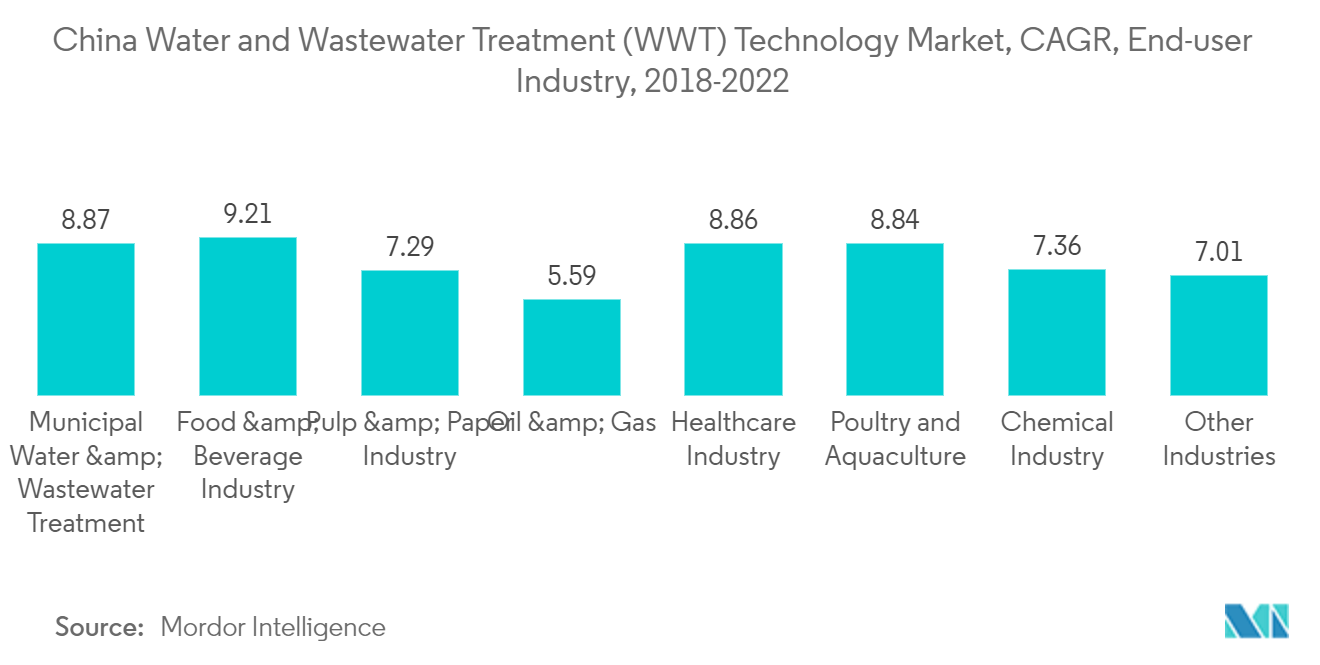Market Trends of China Water And Wastewater Treatment (WWT) Technology Industry
Treatment Equipment to Dominate the Market
- The oil/water separation equipment is widely used in the oil and gas industry to separate oil and water, followed by oil processing to produce downstream products. Oil and water treatment industries are the largest segments that require the usage of gravity separators and hydro cyclones.
- Suspended solids removal is a primary treatment process for wastewater treatment, where suspended solids and floating materials are effectively removed. Effluent is passed through various stages to remove materials, such as wood pieces, plastic, paper, floating debris, metals, sand, clay, silt, ash, and other organic matter.
- Total dissolved solids (TDS) are the compounds left in the water after normal treatment and filtration. Drinking water contains hazardous chemicals from different water treatment plants. In such a situation, using the proper filtration processes to remove the contaminants and make water safe for consumption is essential.
- Biological treatment is an integral part of the wastewater treatment process. It treats the industry and municipality wastewater, which contains soluble organic impurities. This treatment technology uses organisms to break down the organic substances in wastewater, including nematodes, bacteria, and other small organisms.
- The high concentration of metals in water can affect plants, animals, and humans, increasing the risk of skin and lung cancer and possibly affecting the nervous system. Thus, it is imperative to eliminate these dissolved metals in industrial process water before it is released or reused.
- The major technologies used in the municipal water and wastewater treatment industry include biological treatment, suspended solids removal, and disinfection/oxidation. The urban sewage treatment capacity is also likely to increase because of the increasing urban population and municipal wastewater treatment. The urban population share in China increased from 64.72% in 2021 to 65.22% in 2022.
- Moreover, according to International Trade Administration, China plans to build or renovate 80,000 km of sewage collection pipeline networks and increase sewage treatment capacity by 20 million cubic meters/day between 2021 and 2025.
- Treatment equipment is expected to dominate the market due to the factors above.

Municipal Water and Wastewater Treatment to Dominate the Market
- Municipal wastewater is the water drained from toilets, showers, sinks, bathrooms, washing machines, dishwashers, and liquid industrial waste. Municipal wastewater should be treated before releasing it into the environment to avoid damage to the environment and the spreading of harmful diseases.
- With depleting water resources, the impending water crisis forced governments to reevaluate the existing municipal wastewater management infrastructure and take necessary steps to increase the water treatment capacity of existing plants. Therefore, the demand for wastewater treatment chemicals is anticipated to be strengthened during the forecast period.
- The major applications of treatment technologies include preliminary treatment, primary and secondary treatment, tertiary treatment, biological nutrient removal (BNR), resource recovery, energy generation, and others.
- There are nearly 1,944 municipal wastewater treatment plants across China's city/urban regions and 1,599 municipal wastewater treatment plants across China's counties. These plants account for daily processing capacities of 140 and 29 million cubic meters, respectively.
- In the 14th FYP, released in March 2021, China published new guidelines for wastewater reuse, which mandated raising the proportion of sewage that must be treated to reuse standards to 25% by 2025.
- The major technologies used in the municipal water and wastewater treatment industry include biological treatment, suspended solids removal, and disinfection/oxidation. The urban sewage treatment capacity is also likely to increase because of the increasing urban population and municipal wastewater treatment. The urban population share in China increased from 64.72% in 2021 to 65.22% in 2022.
- Moreover, according to International Trade Administration, China plans to build or renovate 80,000 km of sewage collection pipeline networks and increase sewage treatment capacity by 20 million cubic meters/day between 2021 and 2025.
- Thus, the growing number of municipal water treatment plants is projected to benefit the demand for the water treatment chemicals market in the country over the forecast period.


